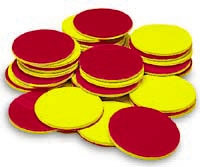Introducing Integers
Integers: Changes in Temperature ModelThe mathematical introduction of integers as positive and negative numbers on the number line is easily accomplished through the real-life application of weather changes in temperature. We are all accustomed to hearing how the temperature will be up or down over the course of the week. Given Monday's temperature, and a series of up and down daily changes, students are challenged to find Friday's temperature. Teachers might use the 5-day weather forecast for your area on Monday. Give students Monday's temperature, then tell them how the temperature will change each day, going up or down from the previous day. Challenge students to find the predicted temperature on Friday, then check it against Friday's actual temperature as part of daily routines. Use the Mathwire Thermometer Template to help students organize the data and use positive and negative integers to reflect the change in temperature from day to day. |

|

|
Integers: Elevator ModelStudents might also use this model to describe riding up and down in an elevator. This real-life application is one some students might have encountered if they live in a large city or have visited taller buildings. Generally problems involve starting at one floor and going up (+) or going down (-) floors to get to another location within the building. This provides a gentle introduction to integers in a familiar format. Some teachers create a fictional store with special floors (e.g. 2 - Kids' Clothing, 3 - Furniture, 4 - Toys, etc.) so that students experience this real-life application of integers. It's easy to generate integer problems using this model: If I get back on the elevator at the 2nd floor, ride up 5 floors, then back down 1, what floor am I on now? Challenge students to write their own Where in the Building Am I Now? problems for classmates to solve. These student-generated problems require higher-order thinking skills and students truly enjoy solving problems created by their peers. |
Integers: Eli and the Magic Peanuts ModelThis model was developed and used in the CSMP (Comprehensive School Mathematics Program) and remains a wonderful introduction to integers for young children. Eli is an elephant who loves peanuts. As he travels through the jungle, he picks up each and every peanut he sees and places them in his bag. The trouble is that some of the peanuts are magic peanuts. They look the same as regular peanuts, so Eli doesn't know if he's picking up a regular or a magic peanut. The problem is that when a regular and a magic peanut get together, they disappear. Eli is always disappointed to find fewer peanuts in his bag when he stops for a snack. Young students love this model and using Mathwire-developed resources to "poof" the peanuts when a regular and magic peanut get together. |

|

|
Integers: Two-Color Counter ModelThis model is commonly used in the middle grades to model adding and subtracting integers using the 2-color counters widely available in classrooms. Usually the red side is used for negative integers and the yellow or white side represents positive integers. As with the Eli model above, a red and white (yellow) counter together represent 0, as -1 and +1 would represent no change. This is an important concept that students must master to use this model effectively. |
Integers: Number Line ModelThis model naturally extends the familiar number line to the left of 0 and now includes the opposites of each number on the number line. Students use familiar hops to move to the right for positive changes or to the left for negative changes. |

|
